Obstructive sleep apnoea is a sleep –related breathing disorder. The Greek word apnoea directly translates as “without breath”. Obstructive Sleep Apnoea (OSA) is a common and serious condition wherein a person’s throat and air passage collapse or relax during sleep, causing him to stop breathing for about 10 seconds several times during his sleep cycle. The level of the affected person’s blood oxygen desaturation is from 3 -4%. The lack of oxygen wakes the person up from sleep several times each night. Lack of sleep may eventually lead to constant fatigue, irritability and difficulty focusing on his daily routine.
Untreated OSA could lead to health issues such as
- Stroke
- Heart attack
- Diabetes
- High blood pressure
- Depression
- Cardiac Arrhythmias
- Glaucoma
- Morning Headache
- Chronic Fatigue
- Congestive Heart Failure
Signs of Sleep Apnoea
Do you have the tell-tale signs of sleep apnoea? Check out CPAP Victoria’s post on sleep apnoea self-test. This is a series of pertinent questions that answer to determine if you are a possible OSA patient. This test is by no means a diagnosis. You still have to consult with a qualified sleep doctor to diagnose and treat OSA.
CPAP Therapy
Continuous Positive Airway Pressure or CPAP therapy is the most effective treatment for OSA. Regulated air is delivered to the person by means of a tube and a mask. The machine itself provides a steady airflow to keep the patient’s airway open for the maintenance of uninterrupted breathing while he sleeps.
Masks
A qualified sleep doctor prescribes the CPAP machine’s air pressure level for an efficient and effective therapy. The air is delivered by means of a full facial mask, nasal pillows, a nasal mask or a nasal prong mask. The full face mask is recommended for patients who breathe through the mouth and nose. Nasal pillows seal the nasal opening through which the air pressure is delivers. A nasal mask seals around the nose while the nasal prong mask seals inside the nares.
Types of PAP Machine
There are different types of PAP machines based on the levels of air pressure they deliver during sleep. There are the CPAP, APAP, BiPAP and BiLevel machines. CPAP machines are titrated to one set of pressure as prescribed by a sleep specialist. An APAP machine has 2 pressure settings of low range and high range that are both calibrated to prevent the patient’s airway from collapsing. A BiPAP or Bilevel Positive Airway Pressure machine has two pressure setting of low pressure range for exhalation (epap) and high pressure range for inhalation (ipap).
There are various designs of PAP machine by different manufacturers. The thrust of the manufacturers is to design a PAP machine that offers the best therapy in the most comfortable way. In relation, there are machines with comfort features such as EPR or FLEX technology, making therapy more comfortable and natural.
Why CPAP Therapy?
CPAP users have attested to the benefits of using the machine. Aside from improving their quality of sleep, their general quality of life has vastly improved. They feel more energized and motivated. Their performance at work improved. They no longer feel moody or depressed. Even their personal relationships improved. Health-issues relating to co-morbidities of OSA decreased.
































